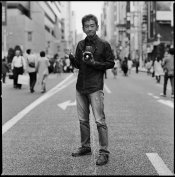It's well known fact that you can "get away" with a worse lens the larger the format is. For example a stopped down triplet in front of a 4x5 piece of film, will still kill a Double Gauss of the highest quality on a 135 camera WRT resolution.
Nothing new in that.
You seem caught in a loop of repetition and truisms.
Less resolution is less resolution.
If you want resolution, the Epson is not where to get it.
And stop comparing to the Flextight. That scanner brand was never optimal for either 135 and esp, not for large format.
Not terrible, but not optimal either.
The fifty percent MTF limit is for lenses and was something agreed upon with the advent of serious digital cameras.
Have you ever seen the MTF curve for a sensor?
Film was always meant to have contrast and microcontrast controlled in printing and now when scanned too. This will bring the the low contrast detail up.
Somewhat the way big hexerei is performed to the raw Bayer image off the sensor.
The way we as humans perceive contrast and detail depends very much on how large the print is too.
ABX tests have show that in large prints, practically everyone prefer the subtle degradation of detail with film, rather that the sudden cliffside falloff into mush or pixels with digital.
And there clearly is grain aliasing. What else would you attribute the pseudo grain to?
If 135 benefits from DSLR scanning medium format does too. Simple as that.
You might not get quite a resolution increase precisely equivalent to larger area of film, but it's damn close. And the grain is the same, so to avoid GA you need the resolution anyway.
Many experiments have shown that there is new detail to be had from a 135 piece film up to about 80 MP, and with stuff like ADOX CMS 20 even higher.
It all depends on the lens, the precision in focus and if a tripod was used of course.
The same goes for digital of course.
My guess would be even with VR/IBIS and autofocus, that ninety percent or more of all digital shots are not resolving to the full potential of the sensor.
Difference is that with film, you are punished for not scanning at the highest possible resolution.




